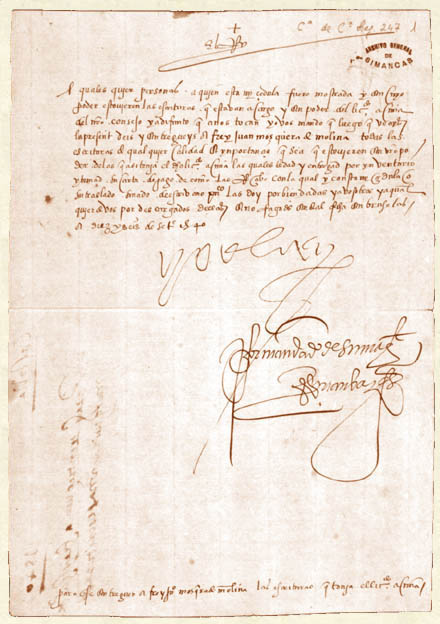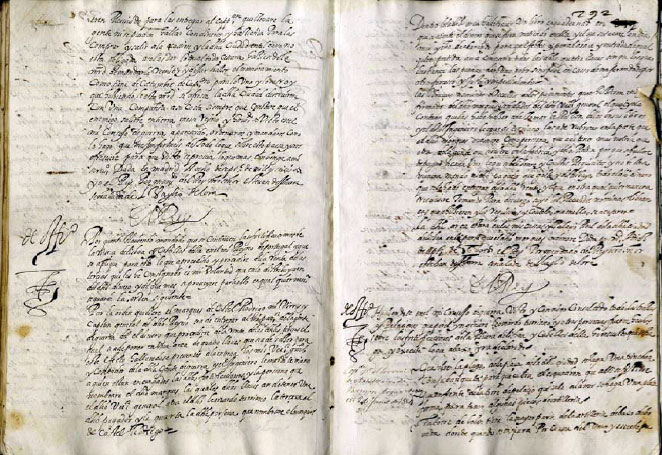Archivo General De Simancas on:
[Wikipedia]
[Google]
[Amazon]
The General Archive of Simancas (also known by its acronym, ''AGS'') is an official archive located in the

 The archive was placed in Simancas, a town some 10 km away from
The archive was placed in Simancas, a town some 10 km away from
Castle of Simancas
The Castle of Simancas (also known as Simancas Castle) is a fortified complex in Simancas, central Spain. The castle stands in the center of town and houses the current Archivo General de Simancas.
History
The site of the castle was at one ti ...
, in the town of Simancas
Simancas is a town and municipality of central Spain, located in the province of Valladolid, part of the autonomous community of Castile and León. It is situated approximately 10 km southwest of the provincial capital Valladolid, on the ro ...
, province of Valladolid
Valladolid () is a Provinces of Spain, province of northwest Spain, in the central part of the Autonomous communities of Spain, autonomous community of Castile-Leon, Castile and León. It has a population of 520,716 people in a total of 225 munici ...
, Castile and León
Castile and León ( es, Castilla y León ; ast-leo, Castiella y Llión ; gl, Castela e León ) is an autonomous community in northwestern Spain.
It was created in 1983, eight years after the end of the Francoist regime, by the merging of the ...
, Spain
, image_flag = Bandera de España.svg
, image_coat = Escudo de España (mazonado).svg
, national_motto = ''Plus ultra'' (Latin)(English: "Further Beyond")
, national_anthem = (English: "Royal March")
, i ...
. It was founded in 1540, making this the first official archive of the Crown of Castile
The Crown of Castile was a medieval polity in the Iberian Peninsula that formed in 1230 as a result of the third and definitive union of the crowns and, some decades later, the parliaments of the kingdoms of Castile and León upon the accessi ...
.
The chronological evolution of the institution has been influenced by the history of the Crown of Castile
The Crown of Castile was a medieval polity in the Iberian Peninsula that formed in 1230 as a result of the third and definitive union of the crowns and, some decades later, the parliaments of the kingdoms of Castile and León upon the accessi ...
. The moments of strength or weakness of the Spanish monarchy
, coatofarms = File:Coat_of_Arms_of_Spanish_Monarch.svg
, coatofarms_article = Coat of arms of the King of Spain
, image = Felipe_VI_in_2020_(cropped).jpg
, incumbent = Felipe VI
, incumbentsince = 19 Ju ...
have been reflected in the regularity of documents' arrivals or conversely in the shortages of resources. A major milestone occurred in 1588, when Philip II of Spain
Philip II) in Spain, while in Portugal and his Italian kingdoms he ruled as Philip I ( pt, Filipe I). (21 May 152713 September 1598), also known as Philip the Prudent ( es, Felipe el Prudente), was King of Spain from 1556, King of Portugal from ...
issued the charter of the Archives of Simancas, a key document for understanding the management of both this archive and others in the peninsula. Also, the damage suffered during the Spanish War of Independence (the Peninsular War
The Peninsular War (1807–1814) was the military conflict fought in the Iberian Peninsula by Spain, Portugal, and the United Kingdom against the invading and occupying forces of the First French Empire during the Napoleonic Wars. In Spain ...
) had a major impact on the institution.
Currently, the AGS is a cultural institution funded by the Ministry of Culture of Spain
The Ministry of Culture and Sport (MCD) is the department of the Government of Spain responsible for the promotion, protection and dissemination of the Spanish historical heritage, national museums, art, books, reading and literary creation, ...
dedicated to conservation, cataloging and research. These activities have brought about the reputation of the archive as one of the cornerstones of the Iberian Peninsula in its preservation and custody of documents.
UNESCO
The United Nations Educational, Scientific and Cultural Organization is a specialized agency of the United Nations (UN) aimed at promoting world peace and security through international cooperation in education, arts, sciences and culture. It ...
awarded the General Archive of Simancas with the distinction of World Heritage Site
A World Heritage Site is a landmark or area with legal protection by an international convention administered by the United Nations Educational, Scientific and Cultural Organization (UNESCO). World Heritage Sites are designated by UNESCO for h ...
in 2017 within its category ''Memory of the World Programme
Memory is the faculty of the mind by which data or information is encoded, stored, and retrieved when needed. It is the retention of information over time for the purpose of influencing future action. If past events could not be remembered, ...
''.
Location

 The archive was placed in Simancas, a town some 10 km away from
The archive was placed in Simancas, a town some 10 km away from Valladolid
Valladolid () is a Municipalities of Spain, municipality in Spain and the primary seat of government and de facto capital of the Autonomous communities of Spain, autonomous community of Castile and León. It is also the capital of the province o ...
. The place was not chosen randomly but was selected because it was well fortified and easily defended.
During the period of the Reconquista
The ' (Spanish, Portuguese and Galician for "reconquest") is a historiographical construction describing the 781-year period in the history of the Iberian Peninsula between the Umayyad conquest of Hispania in 711 and the fall of the Nasrid ...
, the village of Simancas was relevant as a frontier zone. Subsequently, its strategic location between the kingdoms of León and Castile gave it a political role in that period. After the conquest of Toledo and its territory in 1085 the town lost its importance, and in the 13th century was just one of many towns on the outskirts of Valladolid. However, it soon ceased to be part of the jurisdiction of Valladolid, because in 1465 King Henry IV of Castile
Henry IV of Castile ( Castilian: ''Enrique IV''; 5 January 1425 – 11 December 1474), King of Castile and León, nicknamed the Impotent, was the last of the weak late-medieval kings of Castile and León. During Henry's reign, the nobles became ...
ceded some powers to the city of Simancas to encourage it to remain faithful to him.
Until 1917, modern and contemporary historians dated Simancas castle to the time of the Reconquest. However, in that year Francisco Rodríguez Marín published a paper in which he stated that Simancas castle had been taken by Admiral Fadrique under Henry IV, and later was demolished and rebuilt by his son, Admiral Alonso Enriquez. Thus, the construction date of the current castle can be assigned between the years 1467 and 1480. The castle has been extensively renovated over the centuries, and few traces of its original structure remain.
Factors that led to the decision to choose the castle of Simancas as an archive include the fact that, after advancing the frontiers of Christian territory to southern territories, the castle no longer had a specific function in peacetime. That meant that it had other uses, from being a weapons cache to acting as a state prison, functions that were served at the same time as being an archive. There was also the influence of Francisco de los Cobos, ''Comendador Mayor de León'', a member of the Carlos I Carlos I may refer to:
*Carlos I of Spain (1500–1558), also Charles V of the Holy Roman Empire
*Carlos I of Portugal (1863–1908), King of Portugal
*Juan Carlos I of Spain
Juan Carlos I (;,
* ca, Joan Carles I,
* gl, Xoán Carlos I, ...
's Court who exerted all his influence in order to place the archive in Simancas.
The castle was not a place designed to house an archive, which means that there are some problems that have concerned archivists throughout history. The most important of these is the risk of fire. In the past, sharing archive space with a gaol increased the risk that the records might be reduced to ashes. Moreover, being a fortress, the building was a prime target in armed conflicts, such as the Spanish War of Independence
The Peninsular War (1807–1814) was the military conflict fought in the Iberian Peninsula by Spain, Portugal, and the United Kingdom against the invading and occupying forces of the First French Empire during the Napoleonic Wars. In Spain, ...
of 1808-1814.
The building was not designed to keep documents nor for research, so the ornamentation was not intended to extol scholarship but rather royal power. For example, one of the doors of the AGS was decorated with the coat of arms of king Philip II. Furthermore, it has long been difficult to accommodate the researchers. Some improvements have been made over the years to address this trouble.
See also
* List of collections in the Archivo General de Simancas (in Spanish)Further reading
* *External links
* * * {{Authority control Archives in Spain Province of Valladolid Kingdom of Castile Memory of the World Register in Spain